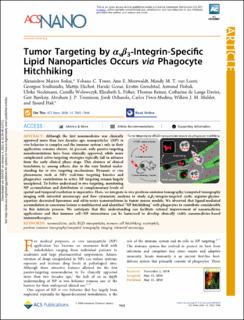| dc.contributor.author | Sofias, Alexandros Marios | |
| dc.contributor.author | Toner, Yohana C. | |
| dc.contributor.author | Meerwaldt, Anu E. | |
| dc.contributor.author | van Leent, Mandy M. T. | |
| dc.contributor.author | Soultanidis, Georgios | |
| dc.contributor.author | Elschot, Mattijs | |
| dc.contributor.author | Gonai, Haruki | |
| dc.contributor.author | Grendstad, Kristin | |
| dc.contributor.author | Flobak, Åsmund | |
| dc.contributor.author | Neckmann, Ulrike | |
| dc.contributor.author | Wolowczyk, Camilla | |
| dc.contributor.author | Fisher, Elizabeth L. | |
| dc.contributor.author | Reiner, Thomas | |
| dc.contributor.author | Davies, Catharina de Lange | |
| dc.contributor.author | Bjørkøy, Geir | |
| dc.contributor.author | Teunissen, Abraham J. P. | |
| dc.contributor.author | Ochando, Jordi | |
| dc.contributor.author | Pérez-Medina, Carlos | |
| dc.contributor.author | Mulder, Willem J. M. | |
| dc.contributor.author | Hak, Sjoerd | |
| dc.date.accessioned | 2021-01-25T14:50:16Z | |
| dc.date.available | 2021-01-25T14:50:16Z | |
| dc.date.created | 2020-05-28T15:58:38Z | |
| dc.date.issued | 2020 | |
| dc.identifier.citation | ACS Nano. 2020, 14 (7), 7832-7846. | en_US |
| dc.identifier.issn | 1936-0851 | |
| dc.identifier.uri | https://hdl.handle.net/11250/2724616 | |
| dc.description.abstract | Although the first nanomedicine was clinically approved more than two decades ago, nanoparticles’ (NP) in vivo behavior is complex and the immune system’s role in their application remains elusive. At present, only passive-targeting nanoformulations have been clinically approved, while more complicated active-targeting strategies typically fail to advance from the early clinical phase stage. This absence of clinical translation is, among others, due to the very limited understanding for in vivo targeting mechanisms. Dynamic in vivo phenomena such as NPs’ real-time targeting kinetics and phagocytes’ contribution to active NP targeting remain largely unexplored. To better understand in vivo targeting, monitoring NP accumulation and distribution at complementary levels of spatial and temporal resolution is imperative. Here, we integrate in vivo positron emission tomography/computed tomography imaging with intravital microscopy and flow cytometric analyses to study αvβ3-integrin-targeted cyclic arginine-glycine-aspartate decorated liposomes and oil-in-water nanoemulsions in tumor mouse models. We observed that ligand-mediated accumulation in cancerous lesions is multifaceted and identified “NP hitchhiking” with phagocytes to contribute considerably to this intricate process. We anticipate that this understanding can facilitate rational improvement of nanomedicine applications and that immune cell–NP interactions can be harnessed to develop clinically viable nanomedicine-based immunotherapies. | en_US |
| dc.language.iso | eng | en_US |
| dc.publisher | ACS - American Chemical Society | en_US |
| dc.rights | Navngivelse 4.0 Internasjonal | * |
| dc.rights.uri | http://creativecommons.org/licenses/by/4.0/deed.no | * |
| dc.title | Tumor Targeting by αvβ3-Integrin-Specific Lipid Nanoparticles Occurs via Phagocyte Hitchhiking | en_US |
| dc.type | Journal article | en_US |
| dc.type | Peer reviewed | en_US |
| dc.description.version | publishedVersion | en_US |
| dc.source.pagenumber | 7832-7846 | en_US |
| dc.source.volume | 14 | en_US |
| dc.source.journal | ACS Nano | en_US |
| dc.source.issue | 7 | en_US |
| dc.identifier.doi | 10.1021/acsnano.9b08693 | |
| dc.identifier.cristin | 1813085 | |
| cristin.ispublished | true | |
| cristin.fulltext | original | |
| cristin.qualitycode | 1 | |

